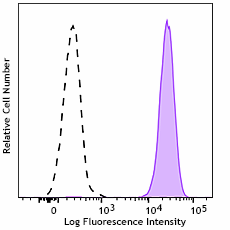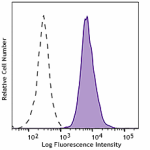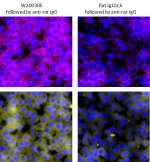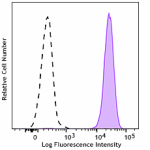- Clone
- W20030E (See other available formats)
- Regulatory Status
- RUO
- Other Names
- Carcinoembryonic antigen-related cell adhesion molecule 6
- Isotype
- Rat IgG2a, κ

-

Human peripheral blood granulocytes were stained with anti-human CD66c (clone W20030E) PE (filled histogram) or rat IgG2a, κ PE isotype control (open histogram).
| Cat # | Size | Price | Quantity Check Availability | ||
|---|---|---|---|---|---|
| 386105 | 25 tests | $120.00 | |||
| 386106 | 100 tests | $285.00 | |||
Carcinoembryonic antigen (CEA) Cell Adhesion Molecule 6 (CEACAM6) belongs to the (CEA) family whose members are glycosyl phosphatidyl inositol (GPI) anchored cell surface glycoproteins. As a cell adhesion molecule, CEACAM6 mediates homotypic binding with other CEA family members and heterotypic binding with integrin receptors. CEACAM6 is expressed on epithelial surfaces and in the myeloid lineage. Despite lacking transmembrane and intracellular domains, GPI-anchored proteins, including CEACAM family members, are able to influence transmembrane signaling via tyrosine kinases. CEACAM6 modulates c-Src tyrosine kinase activity. Overexpressed in more than 50% of all human adenocarcinomas, CEACAM6 promotes aberrant cell differentiation, anti-apoptosis, cell growth and resistance to therapeutic agents, cell invasion and metastasis.
Product Details
- Verified Reactivity
- Human
- Antibody Type
- Monoclonal
- Host Species
- Rat
- Immunogen
- Recombinant protein, aa 35-320
- Formulation
- Phosphate-buffered solution, pH 7.2, containing 0.09% sodium azide and BSA (origin USA)
- Preparation
- The antibody was purified by affinity chromatography and conjugated with PE under optimal conditions.
- Concentration
- Lot-specific (to obtain lot-specific concentration and expiration, please enter the lot number in our Certificate of Analysis online tool.)
- Storage & Handling
- The antibody solution should be stored undiluted between 2°C and 8°C, and protected from prolonged exposure to light. Do not freeze.
- Application
-
FC - Quality tested
- Recommended Usage
-
Each lot of this antibody is quality control tested by immunofluorescent staining with flow cytometric analysis. For flow cytometric staining, the suggested use of this reagent is 5 µL per million cells in 100 µL staining volume or 5 µL per 100 µL of whole blood. It is recommended that the reagent be titrated for optimal performance for each application.
- Excitation Laser
-
Blue Laser (488 nm)
Green Laser (532 nm)/Yellow-Green Laser (561 nm)
- RRID
-
AB_3068032 (BioLegend Cat. No. 386105)
AB_3068032 (BioLegend Cat. No. 386106)
Antigen Details
- Structure
- Glycosyl phosphatidyl inositol (GPI) anchored cell surface glycoproteins Immunoglobulin superfamily
- Distribution
-
Apical Cell Membrane
- Function
- The extracellular N-terminus Ig-like V-type domain is necessary for homophilic and heterophilic intercellular adhesion.
- Interaction
- Mediates homophilic and heterophilic cell adhesion with other carcinoembryonic antigen-related cell adhesion molecules, such as CEACAM5 and CEACAM8
- Cell Type
- Epithelial cells, Granulocytes
- Biology Area
- Immunology
- Molecular Family
- Adhesion Molecules, CD Molecules
- Antigen References
-
- Duxbury MS, et al. 2004. Oncogene. 23:465-73.
- Oikawa S, et al. 1991. J Biol Chem. 266:7995-8001.
- Noworolska A, et al. 1986. Cancer Detect Prev. 9:365-71.
- Wu S, et al. 2021. Transl Oncol. 14:101057
- Gene ID
- 4680 View all products for this Gene ID
- UniProt
- View information about CD66c on UniProt.org
Other Formats
View All CD66c Reagents Request Custom Conjugation| Description | Clone | Applications |
|---|---|---|
| Ultra-LEAF™ Purified anti-human CD66c | W20030E | ICC,FC,Block,Activ |
| PE anti-human CD66c | W20030E | FC |
Compare Data Across All Formats
This data display is provided for general comparisons between formats.
Your actual data may vary due to variations in samples, target cells, instruments and their settings, staining conditions, and other factors.
If you need assistance with selecting the best format contact our expert technical support team.
-
Ultra-LEAF™ Purified anti-human CD66c

The human lung adenocarcinoma cell line A549 was grown on 96... 
Human peripheral blood granulocytes were stained with Ultra-... 
The effect of clone W20030E to induce CD66c signaling by cro... 
The effect of Ultra-LEAF™ anti-human CD66c (clone W20030E) o... 
The effect of Ultra-LEAF™ anti-human CD66c (clone W20030E) o... -
PE anti-human CD66c

Human peripheral blood granulocytes were stained with anti-h...
